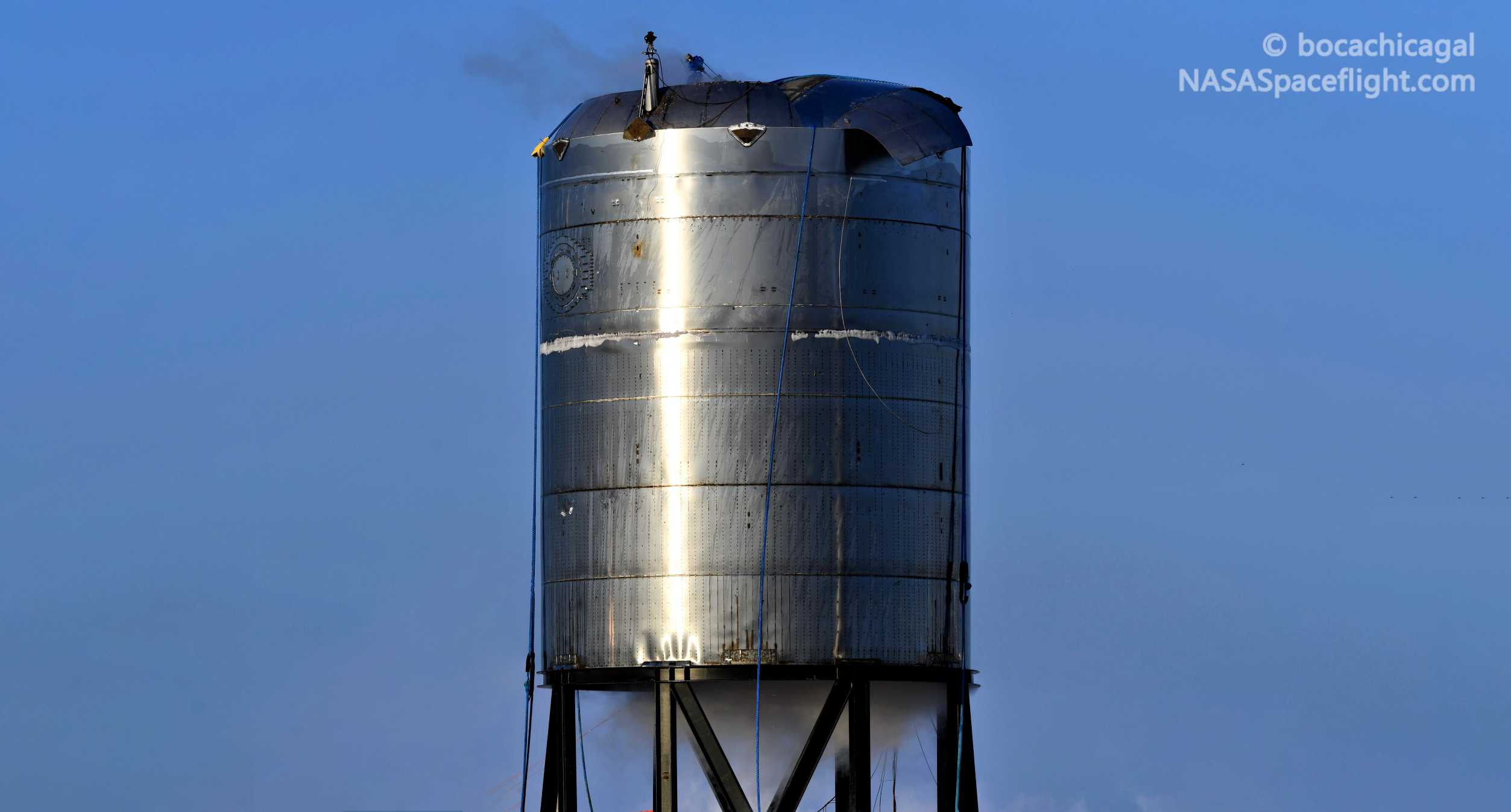
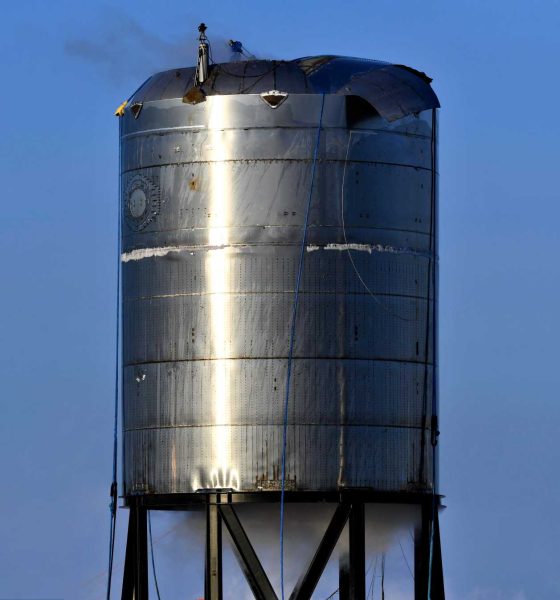
News
SpaceX Starship pop test opens the door for 60,000 foot hop [update]
SpaceX has successfully destroyed a Starship ‘test tank’ for the fourth time, opening the door for the first high-altitude prototype to roll to the launch pad as soon as tomorrow.
The culmination of three nights and more than 20 hours of concerted effort, SpaceX was finally able to fill Starship test tank SN7.1 with several hundred tons of liquid nitrogen before dawn on September 23rd. With just an hour left in the day’s test window, SpaceX closed the tank’s vents, allowing its cryogenic contents to boil into gas and expand with no outlet. At 4:57 am CDT, SN7.1 burst, bringing its lengthy test campaign to a decisive end.
A handful of hours later, new road closure notices revealed SpaceX’s plan to roll Starship SN8 – the first full-size prototype and first ship meant for high-altitude testing – from its Boca Chica factory to the launch site.
Update: All road closures planned for Starship SN8’s roll to the launch pad (Sept 24) and first test campaign (Sept 27-29) have been canceled. Stay tuned for updates on the high-altitude prototype’s test schedule.
Short of new information from SpaceX or CEO Elon Musk, little is known about the results of SN7.1’s lengthy test campaign, but the fact that it survived two nights of nondestructive testing – including the use of hydraulic rams to simulate Raptor thrust – effectively clears Starship SN8 for suborbital testing. Based on a speculative, amateur analysis of the aftermath of SN7.1’s burst test, it can also be tentatively concluded that the tank failed almost exactly where one would expect it to: the in-situ weld attaching the upper tank dome to SN7.1’s steel ring hull.
SN7.1’s forward dome appears to have cleanly sheared off around much of its circumferential weld joint – exactly what one would theoretically expect from a good, uniform weld. Assuming that SN7.1 reached pressures well above 8.5 bar (~125 psi) before it burst, the tank’s final test can likely be deemed a success.
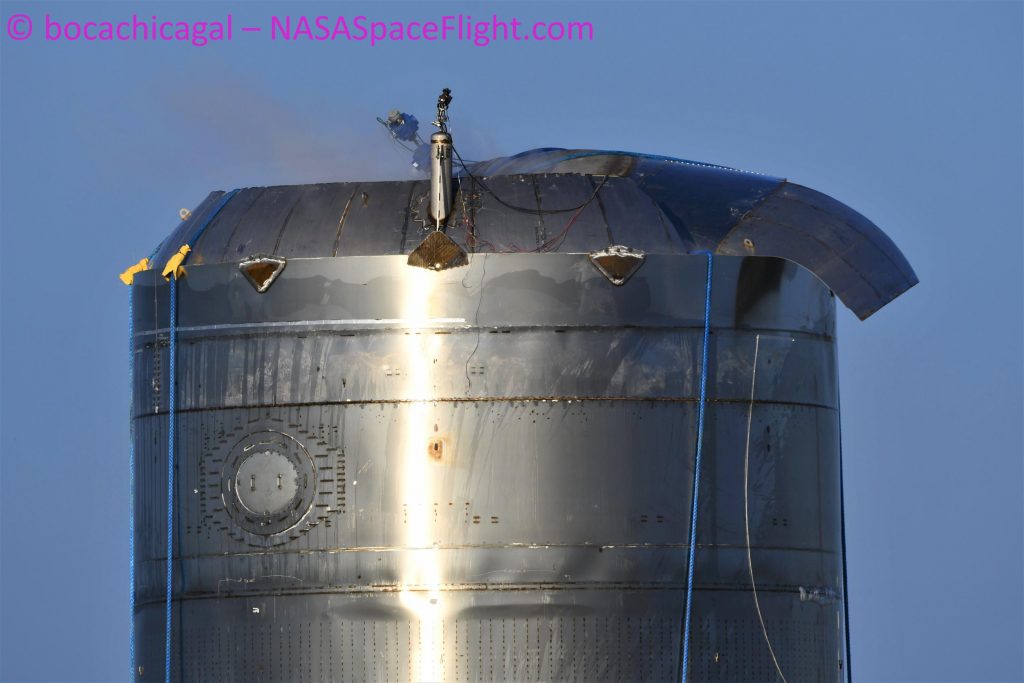
The very same day SpaceX kicked off what would become Starship SN7.1’s last burst test attempt, teams worked to install functional flaps on a full-scale Starship prototype (SN8) for the first time ever. Effectively answering the question of whether SpaceX would fully outfit the ship with a nosecone and flaps before its first acceptance tests, SN7.1’s successful pop was followed by road closure notices for SN8’s transport to the launch pad around dawn on September 24th and cryptic “SN8 Testing” as early as September 27th.
As of September 23rd, SN8’s twin aft flaps – large aerodynamic control surfaces meant to stabilize free-falling Starships – have been fully installed alongside ‘aerocovers’ that will protect each flap’s control mechanisms. The only hardware Starship SN8 is missing is a ~20m (~60 ft) tall nosecone, two smaller forward flaps, and the plumbing needed to access a smaller liquid oxygen “header” tank located in the tip of said nose.
At the moment, SpaceX has installed one Starship nosecone prototype atop five unpressurized rings – creating a full nosecone stack. That particular prototype has no liquid oxygen header tank, however, meaning that SpaceX would likely need at least a day or two to weld one of the noses with a header tank atop one of several finished five-ring sections. In other words, to transport SN8 to the pad tomorrow, there’s almost no chance that SpaceX will have time to finish and install a proper nosecone on the prototype, meaning that the company has chosen to test the Starship before that milestone.
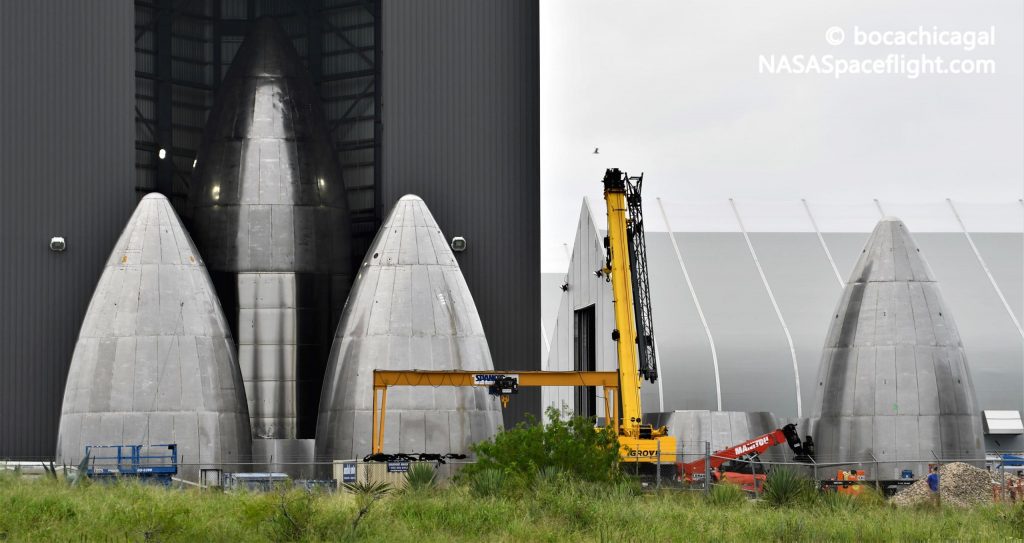
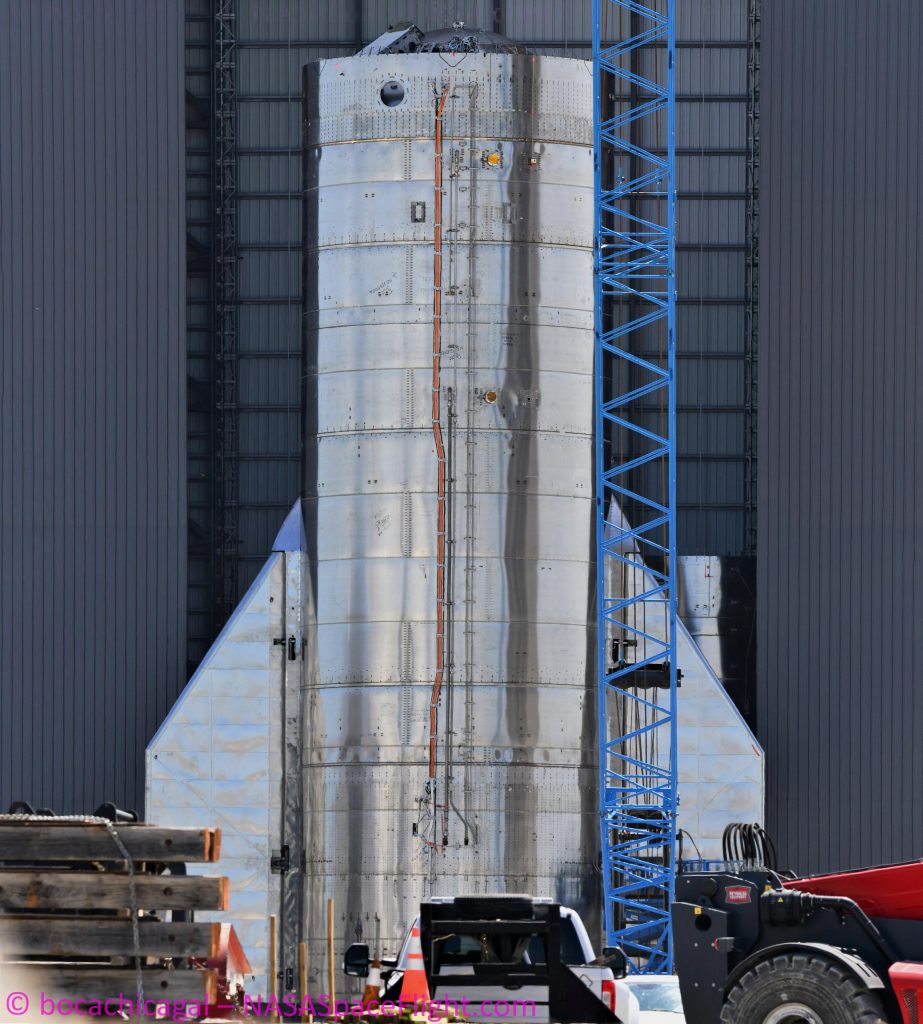
Doing so should reduce any inconvenience caused by vehicle failure in the event that Starship SN8’s acceptance test campaign doesn’t go as planned. In hindsight, the inclusion of Starship SN8’s aft flaps and aerocovers during the ship’s first major tests was likely a necessity, given that almost half of each flap and its support structure is installed directly to the skin of its liquid oxygen tank. Theoretically, when chilled to the temperature of liquid nitrogen or oxygen, the diameter of the stainless steel rings Starship SN8 is built out of could shrink by as much as 0.3% (~20 mm or ~0.8 in).
Only half of Starship SN8’s aft flaps will be directly subject to that tank contraction, resulting in a relatively complex environment for such a large, high-stress mechanical system. As such, testing flap actuation under cryogenic loads is likely a critical part of SN8’s cryogenic proof test, otherwise meant to demonstrate the structural integrity and functionality of Starship’s propellant tanks. If SN8 rolls to SpaceX’s launch facilities on schedule, the Starship’s first cryogenic proof test could begin as early as 9pm CDT (UTC-5) on Sunday, September 27th.
Check out Teslarati’s Marketplace! We offer Tesla accessories, including for the Tesla Cybertruck and Tesla Model 3.

News
Tesla FSD fleet is nearing 7 billion total miles, including 2.5 billion city miles
As can be seen on Tesla’s official FSD webpage, vehicles equipped with the system have now navigated over 6.99 billion miles.

Tesla’s Full Self-Driving (Supervised) fleet is closing in on almost 7 billion total miles driven, as per data posted by the company on its official FSD webpage.
These figures hint at the massive scale of data fueling Tesla’s rapid FSD improvements, which have been quite notable as of late.
FSD mileage milestones
As can be seen on Tesla’s official FSD webpage, vehicles equipped with the system have now navigated over 6.99 billion miles. Tesla owner and avid FSD tester Whole Mars Catalog also shared a screenshot indicating that from the nearly 7 billion miles traveled by the FSD fleet, more than 2.5 billion miles were driven inside cities.
City miles are particularly valuable for complex urban scenarios like unprotected turns, pedestrian interactions, and traffic lights. This is also the difference-maker for FSD, as only complex solutions, such as Waymo’s self-driving taxis, operate similarly on inner-city streets. And even then, incidents such as the San Francisco blackouts have proven challenging for sensor-rich vehicles like Waymos.
Tesla’s data edge
Tesla has a number of advantages in the autonomous vehicle sector, one of which is the size of its fleet and the number of vehicles training FSD on real-world roads. Tesla’s nearly 7 billion FSD miles then allow the company to roll out updates that make its vehicles behave like they are being driven by experienced drivers, even if they are operating on their own.
So notable are Tesla’s improvements to FSD that NVIDIA Director of Robotics Jim Fan, after experiencing FSD v14, noted that the system is the first AI that passes what he described as a “Physical Turing Test.”
“Despite knowing exactly how robot learning works, I still find it magical watching the steering wheel turn by itself. First it feels surreal, next it becomes routine. Then, like the smartphone, taking it away actively hurts. This is how humanity gets rewired and glued to god-like technologies,” Fan wrote in a post on X.
News
Tesla starts showing how FSD will change lives in Europe
Local officials tested the system on narrow country roads and were impressed by FSD’s smooth, human-like driving, with some calling the service a game-changer for everyday life in areas that are far from urban centers.

Tesla has launched Europe’s first public shuttle service using Full Self-Driving (Supervised) in the rural Eifelkreis Bitburg-Prüm region of Germany, demonstrating how the technology can restore independence and mobility for people who struggle with limited transport options.
Local officials tested the system on narrow country roads and were impressed by FSD’s smooth, human-like driving, with some calling the service a game-changer for everyday life in areas that are far from urban centers.
Officials see real impact on rural residents
Arzfeld Mayor Johannes Kuhl and District Administrator Andreas Kruppert personally tested the Tesla shuttle service. This allowed them to see just how well FSD navigated winding lanes and rural roads confidently. Kruppert said, “Autonomous driving sounds like science fiction to many, but we simply see here that it works totally well in rural regions too.” Kuhl, for his part, also noted that FSD “feels like a very experienced driver.”
The pilot complements the area’s “Citizen Bus” program, which provides on-demand rides for elderly residents who can no longer drive themselves. Tesla Europe shared a video of a demonstration of the service, highlighting how FSD gives people their freedom back, even in places where public transport is not as prevalent.
What the Ministry for Economic Affairs and Transport says
Rhineland-Palatinate’s Minister Daniela Schmitt supported the project, praising the collaboration that made this “first of its kind in Europe” possible. As per the ministry, the rural rollout for the service shows FSD’s potential beyond major cities, and it delivers tangible benefits like grocery runs, doctor visits, and social connections for isolated residents.
“Reliable and flexible mobility is especially vital in rural areas. With the launch of a shuttle service using self-driving vehicles (FSD supervised) by Tesla in the Eifelkreis Bitburg-Prüm, an innovative pilot project is now getting underway that complements local community bus services. It is the first project of its kind in Europe.
“The result is a real gain for rural mobility: greater accessibility, more flexibility and tangible benefits for everyday life. A strong signal for innovation, cooperation and future-oriented mobility beyond urban centers,” the ministry wrote in a LinkedIn post.
News
Tesla China quietly posts Robotaxi-related job listing
Tesla China is currently seeking a Low Voltage Electrical Engineer to work on circuit board design for the company’s autonomous vehicles.

Tesla has posted a new job listing in Shanghai explicitly tied to its Robotaxi program, fueling speculation that the company is preparing to launch its dedicated autonomous ride-hailing service in China.
As noted in the listing, Tesla China is currently seeking a Low Voltage Electrical Engineer to work on circuit board design for the company’s autonomous vehicles.
Robotaxi-specific role
The listing, which was shared on social media platform X by industry watcher @tslaming, suggested that Tesla China is looking to fill the role urgently. The job listing itself specifically mentions that the person hired for the role will be working on the Low Voltage Hardware team, which would design the circuit boards that would serve as the nervous system of the Robotaxi.
Key tasks for the role, as indicated in the job listing, include collaboration with PCB layout, firmware, mechanical, program management, and validation teams, among other responsibilities. The role is based in Shanghai.
China Robotaxi launch
China represents a massive potential market for robotaxis, with its dense urban centers and supportive policies in select cities. Tesla has limited permission to roll out FSD in the country, though despite this, its vehicles have been hailed as among the best in the market when it comes to autonomous features. So far, at least, it appears that China supports Tesla’s FSD and Robotaxi rollout.
This was hinted at in November, when Tesla brought the Cybercab to the 8th China International Import Expo (CIIE) in Shanghai, marking the first time that the autonomous two-seater was brought to the Asia-Pacific region. The vehicle, despite not having a release date in China, received a significant amount of interest among the event’s attendees.








